Affiliate disclosure: This post may contain affiliate links. Please see our Privacy Policy.
Homemade herbal shampoo is a great choice for those looking for a more natural hair care alternative. Choose to make it completely from scratch, or start with a natural base soap for a simpler recipe.
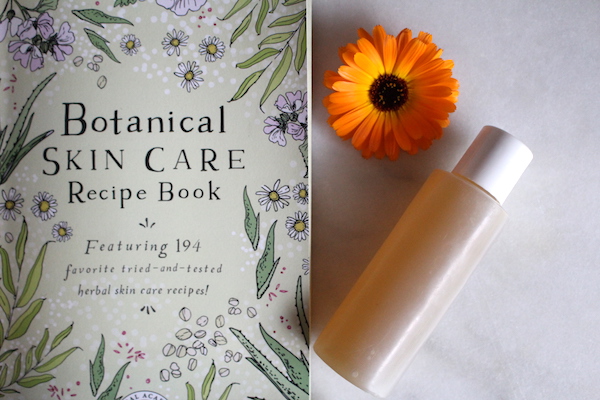
When it comes to hair and skincare I try to keep products to a minimum. I make my own body butter for winter dry skin, as well as herbal lip balms, and salves for cuts and scrapes.
Nourishing goat’s milk soap bars are usually enough for cleansing, and beyond that, I keep an all-natural simple liquid castile soap for everything else. There’s not a whole lot we buy from the beauty care aisle…except for shampoo.
I have friends that rave about giving up shampoo and that love their “no-poo” hair, but with my naturally oily hair, I don’t imagine I’ll ever go that route permanently. I’ve tried it, and several weeks in my hair is still glued down to my head…not a great look.
For the past decade, I’ve used Nature’s Gate Herbal Shampoo and I love it…but it’s pretty expensive. I’ve been searching for quite a while, looking for an alternative to get this last commercial product out of my bathroom and transition to all homemade.
When the Herbal Academy offered to let me review their new Botanical Skin Care Course, I was excited to bring home herbs into my daily skincare routine. Then flipping through the recipe book that accompanies the course, I found a simple recipe for herbal shampoo and I knew what I had to make first!
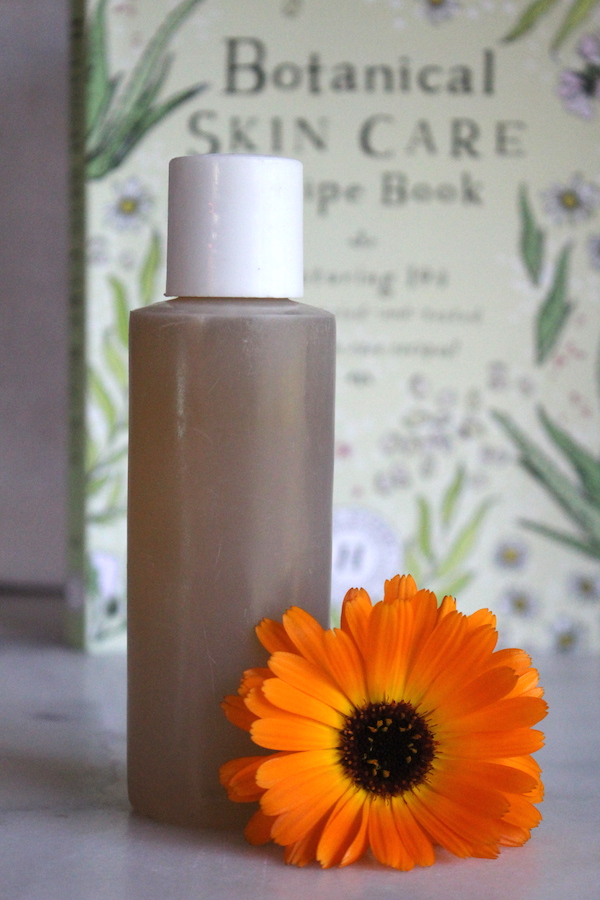
Their recipe for herbal shampoo is quite simple, and is based on a recipe by Rosemary Gladstar in her 2014 book “Herbs for Natural Beauty.” Many of the recipes in this course are based on tried and true recipes adapted from more than a dozen herbal skin care books, and all brought together in one convenient course.
Within the course itself, there are video tutorials on making basic skincare products from cold creams to infused oils and more. I especially love how the course goes through all the potential ingredients for homemade skincare products and explains how and why you’d choose them. It covers everything from exotic ingredients like mango butter and argan oil, down to everyday kitchen things like dried rosemary and olive oil.
Though I already made many of my own skincare products, I’m now going to be making even more now that I know how to choose the right natural clay for my skin, and I’m going to adjust my body butter recipe as well. I’ve learned so much from this Botanical Skin Care Course, and you’ll get to see the fruits of that over the next few months as I share new skincare recipes with you this coming winter.
For now though, I’ll share this simple herbal shampoo recipe with you… let’s start with the herbs and ingredients.
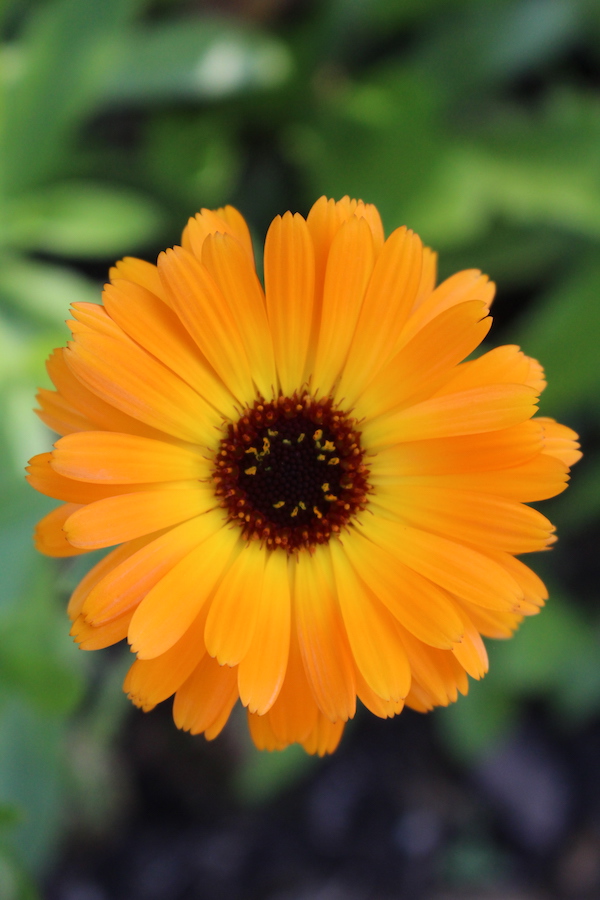
Ingredients for Herbal Shampoo
The base for this herbal shampoo is a simple liquid castile soap. I always keep a couple of big jugs of Dr. Bronner’s liquid castile soap around, and it has plenty of uses around the house, and I even use it in the garden to treat for aphids.
Starting with a liquid castile soap makes this recipe a lot simpler, but if you’re hardcore into all things DIY then you can make your own liquid castile soap with this recipe. Keep in mind you’ll need a special type of lye (Potassium Hydroxide) to make liquid soap, which is different than the lye used for making bar soaps (Sodium Hydroxide).
To that simple soap base, this herbal shampoo recipe adds a herbal tea made from chamomile, rosemary, and calendula. The course gives you the tools to customize this herbal blend and choose herbs that suit your particular skin/hair, but these are great choices for most hair types. Each comes with its own benefits:
- Chamomile ~ A natural herbal treatment for dandruff and scalp issues, chamomile also helps increase hair shine and boost hair growth.
- Calendula ~ A great all-around herb for nourishing the skin, it’s no different for the scalp. It’s added to nourish the skin on your scalp and naturally condition it to prevent dry skin.
- Rosemary ~ Used in natural hair growth formulas, rosemary promotes good blood circulation to the scalp and helps ensure healthy hair follicles. It also adds a delightful scent to this herbal shampoo.
The recipe suggests adding a very small amount of either argan oil or jojoba oil, both of which are perfect for conditioning hair without leaving it oily. My mom adds argan oil to her hair daily, and though it’s not something I keep in the house, she happened to be visiting the week I made this herbal shampoo, so that’s what I used. Small containers of argan oil are pretty inexpensive, and they’re quite rich so it’ll last a very long time.
While I don’t keep argan oil in the house, I do have Jojoba oil on hand as a massage oil. Jojoba isn’t technically an oil in the pure sense of the word, it’s more of liquid wax, which means it won’t stain clothes or leave a greasy feel. When I worked as a massage therapist, this is what I used in my practice because it saved my massage sheets from oil stains and its molecules are actually more absorbable by the skin, since they mimic the skin’s natural lubricants.
Argan oil and jojoba are excellent choices for added conditioning in this soap, but they also serve a second purpose. Adding 1/4 teaspoon might not seem like much, but it’s enough to both condition your hair and serve as a carrier oil to dilute the optional essential oils in this recipe. Essential oils can cause issues if applied undiluted, and it only takes a small amount of carrier oil to help disperse them in this herbal shampoo recipe.
That said, feel free to skip the addition of essential oils for an unscented shampoo. I’m not an expert on essential oils, and while there are some that are reputed to improve hair condition, I haven’t done much research in that area. The herbal skin care course does cover essential oils, but I haven’t studied that section in detail…yet.
The last ingredient in this herbal shampoo is a natural preservative, which is covered in detail in the herbal skincare course. Anytime you’re adding water to a skincare product, especially along with oil as in a homemade lotion, you introduce the potential for bacterial growth.
I’m making this herbal shampoo in small batches since it’s so easy to prepare, so I’m skipping commercial preservatives. If you do choose to add one, there are many available on the market and the botanical skincare course discusses the many options available.
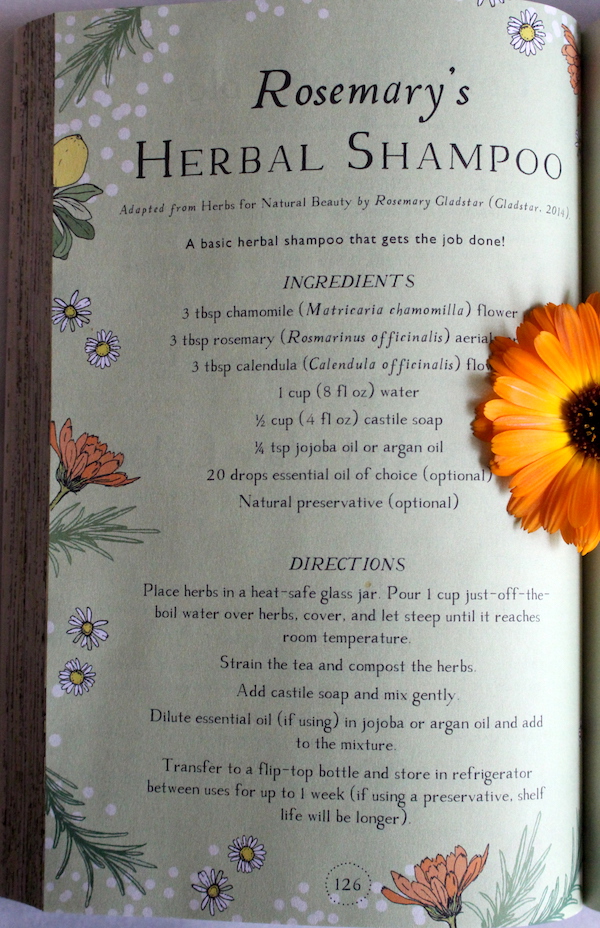
(This recipe for homemade herbal shampoo comes from the Herbal Academy’s botanical skincare course, which they allowed me to take in exchange for my honest review.)
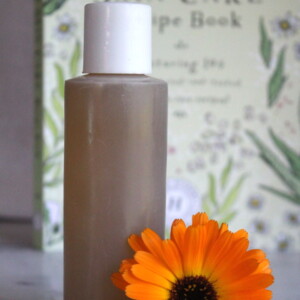
Herbal Shampoo
Ingredients
- 3 tbsp Chamomile flower Matricaria chamomilla
- 3 tbsp Rosemary aerial parts Rosmarinus officinalis
- 3 tbsp Calendula flower Calendula officinalis
- 1 cup water
- 1/2 cup liquid castile soap
- 1/4 tsp argan oil
- or 1/4 tsp jojoba oil
- Natural Preservative such as Leucidal which is derived from radishes ~ Optional
Instructions
- Place herbs in a heat-safe glass jar. Pour 1 cup boiling water over the herbs, cover and let steep until the mixture reaches room temperature (about 20 to 30 minutes).
- Strain the tea and compost the herbs.
- Add the castile soap and gently mix the soap and herbal tea.
- Dilute the essential oils (if using) in the jojoba or argan oil and add that mixture to the soap/tea mixture.
- Optional, if using ~ Add the natural preservative according to the manufacturer's instructions.
- Transfer to a re-usable soap bottle and use within 1 week (without preservatives) or store for extended use with preservatives.
Other Homemade Body Products
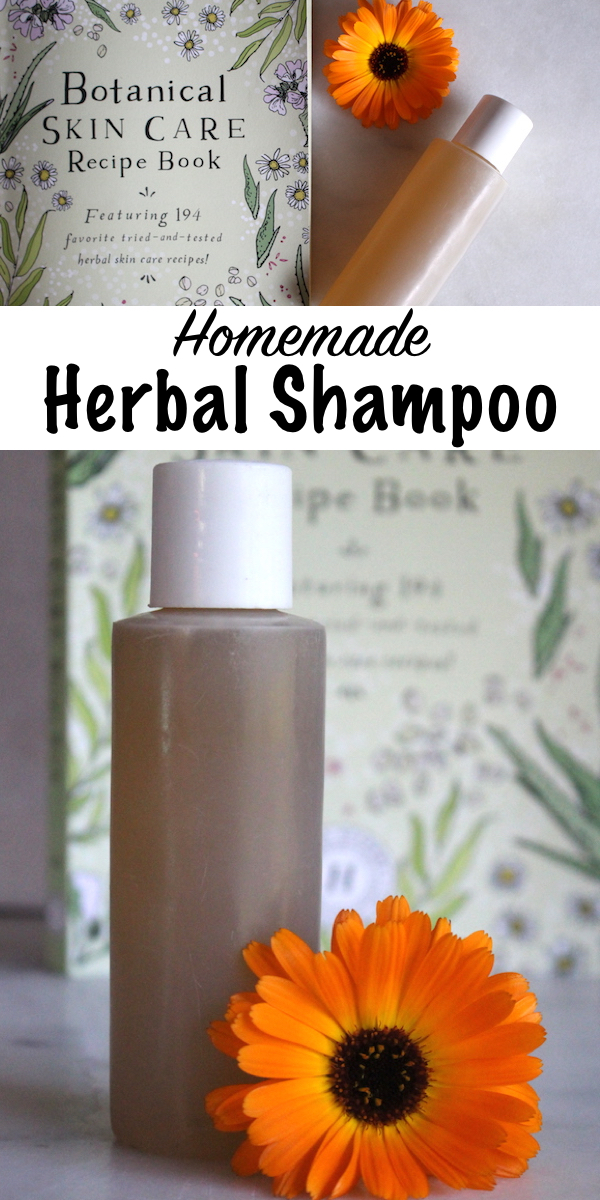


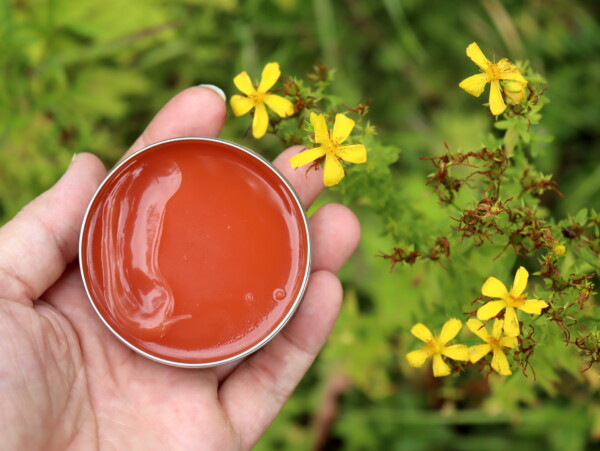
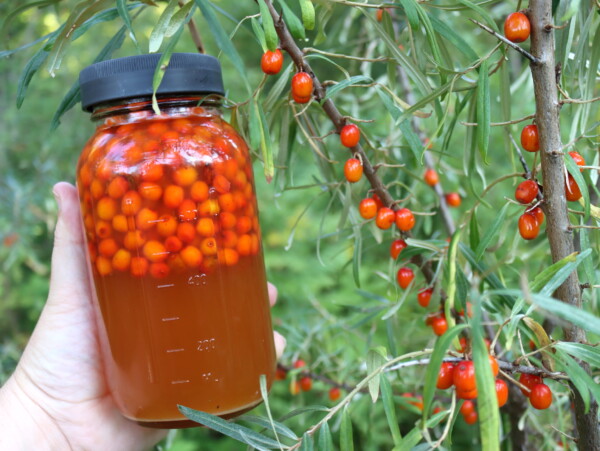
Love the site. Great information all around.
Thanks!
First, hey to another off-grid woman from Northern Canada! It’s actually really nice to meet someone else who gets this lifestyle and enjoys making her own products, too! I was trying to find a nice shampoo option when I ran across your herbal recipe. I was hoping you might know if the addition of Vitamin E (tocopherols) or ROE would work as a preservative? I’m wanting to start small and see how it goes, but if I love it, I obviously want it to have some shelf-life. Thank you in advance and nice to meet you!
Hi Jenne, nice to meet you too! Vitamin E oil works to keep oils from going rancid, but it won’t help you with the flower teas in the bottle. I think a few drops of Vitamin E oil would be lovely in this recipe, and great for your hair, but it won’t keep the mixture from spoiling. If you’re looking for something that’s completely shelf stable without additives (and I get it, I’m right there with you), then you want a shampoo bar.
Hi I made this for someone and she asked if this would ruin her hair that she have highlighted? I use this and love it!
I wouldn’t think that it would but she might want to double check with her hair stylist.
Castile on hair? Castile is an all purpose cleaning soap similar to those old fashioned laundry bars my gramma used to use… I remember using a diluted Dr. Bronner’s on my hair when we were camping once and it’s stripped my hair for a good two weeks. It was like washing it with dish soap./dawn !
Do you find the jojoba in the recipe helps? I think of Castile as something for cleaning everything other than skin hair/body…there must be a more gentle soap base, no?
Thank you for the great ideas, I will try to expand on this recipe w maybe a gentler base… and for people with well water, I have found that Apple cider vinegar makes a fantastic rinse. I keep it diluted in a bottle in the shower and the difference is amazing.!
I think it depends a lot on your hair type but the jojoba oil definitely helps. And yes, vinegar makes a great rinse for all water types.
I’m new to DIY shampoo and I came across this post/recipe. I was actually searching for herbal shampoo bar recipes to try for thinning hair and dry scalp. I love the ingredients in this recipe and was wondering if it could be converted to a bar?
If you are wanting a shampoo bar, check out Jan Berry at http://www.thenerdyfarmwife.com You can find lots of recipes there for shampoo bars.
Thank you for the information on homemade herbal shampoo. I have used them before and gotten good results. I used CavinKare Nyle herbal shampoo for antidandruff and it worked well. It contains curd, Aloe vera and Lemons, and it left my hair soft.
I have never made my own shampoo but reading your blog is inspiring me to try it. Do you know if there are benefits to having cedar leaf and juniper oil in a shampoo? Burt’s Bees used to have a shampoo with these ingredients but it has not been available for many years.
I have heard that both juniper and cedar are beneficial for the hair. You could do some additional research to determine the exact benefits.
Hi, you’ve encouraged me to try making my own shampoo. I can’t wait to gather the ingredients and give it a try. I’m also considering making soap as well.
That’s great! We’re so glad that you have been encouraged. Let us know how you like the shampoo.
For years I’ve been sad to have lost the original version of Nature’s Gate Herbal Conditioner. I’d like to make my own somehow. It was very gentle yet effective and smelled divine (myrrh and lavender). I found the original ingredient list: Purified Water, Extracts of Chamomile, Nettle, Ho-lien-hua, Nelumbo Nucifera, Comfrey Root, Cherry Bark, Schleichera Trijuga, Kusambi Bark, Burdock, and Yucca, Vegetable Emulsifying Wax, Coconut Oil, Methylparaben, Myrrh Oil, Lavender Oil.
You are inspiring me to learn more about making my own shampoo and conditioner. Thank you!
Oh my goodness! Natures gate was the absolute best, and we used to buy it in bulk every year. I was totally devastated when I went in one year and they no longer made it, and honestly I have no idea how to make anything that comes close. I’ve tried literally dozens of conditioners and shampoos, and all were pretty horrible, leaving my hair a mess. I’ve recently found andalou naturals shampoo and conditioner, and though it doesn’t smell the same, it works about the same on my hair. Sorry I don’t have a homemade recipe for you, but hopefully the andalou stuff works for you.
Not really a homemade shampoo when you are using store bought shampoo as the bulk.
I guess I can see why you might say that but if you are purchasing commercial shampoos then this is certainly a step in the right direction. Not everyone is in the same place, so it’s good to have small steps that can be taken to get closer to the goal rather than having an all-or-nothing mindset. For example, if you buy strawberries, sugar and pectin from the grocery store to make jam, I think you’re still making jam. Would it be better to grow your own strawberries? Probably so, but you still made the jam and it’s still better than buying the jam already made from the store, you know the ingredients that are in it and you’re increasing your skill set.
Not to be rude, but that is a very silly comment. You could attempt to make your own base soap but still, you’d have to purchase the ingredients from somewhere, right?
This is a simple, non-time consuming diy shampoo made with wholesome ingredients.
I’m grateful for this recipe as I cannot tolerate commercial shampoos nor do I want to spend the big bucks for all naturals. Not to mention the carbon footprint of transporting the shampoos and all those wasteful throw away plastic bottles.
Just say thank you for this post or maybe move along…being negative like this is quite distasteful, I would say.
God bless, have a great day.
I believe the base is Castile, which you can make yourself if you’re so concerned about commercial products…. but, you need to exit your house to purchase those products to make the Castile…. someone has waayyy too much time on their hands, and waayyy too much strife in their head and heart….. make some yummy smelling soap, sit back, inhale, relax, and enjoy…..
This looks really good. I think I’ll make it with a couple of additions: drop the 3 Tbsp to 2, add in nettle and horsehair for the hair (I have thinning hair pretty bad) and also switch out the argan/jojoba oil for Amla oil, which is one used in India for hair loss. OR a mix I made of Amla, Bhringraj and castor oils with Cedar E.O., Peppermint E.O and Rosemary E.O.
Looking forward to making and using this!
ALSO, YOU MENTION ESSENTIAL OILS BEING DILUTED, BUT YOU DIDN’T MENTION THEM IN THE INGREDIENTS LIST….
Thank you for those great suggestions. Sorry about the essential oils. It looks like it did get left off of the ingredients list in the recipe but it looks like the image of the recipe from the Botanical Skin Care Book shows essential oils listed as 20 drops.
This is an amazing recipe! I’ve made it several times now..
Buti was wondering, if there’s any way, that it naturally can be thickned, just a tiny bit. So you get more of a shampoo-ish consistent.
My mother has a hard time with the liquidy feel of it.
Thank you so much, for sharing all this with us.
Good question, and I honestly don’t have an answer for you. I imagine if you used a thicker liquid soap base, but part of the nice thing about this recipe is that its natural castile soap. Perhaps if you could find a natural liquid soap that was thicker and test it out it might work?
I’ve never made shampoo but hoping to start since I’ve done a lot of research! I believe using a small percentage of salt would naturally thicken the formula.
Don’t you find that using a shampoo like this is hard to rinse with hard well water? I’ve tried a few homemade ways to give up the chemical filed shampoos and everytime there is a build up of grey minerals in my hair. I want to find a solution to getting free from the chemical shampoos!
I’m curious as well, as I have very hard water….. any insight from the last couple years since this was initially posted?
The best way to combat the hard water issue is a good vinegar rinse after shampooing.
Hi Ashley, Thanks for sharing this shampoo recipe! Are you using dried herbs or fresh? Or does it matter? I’ve tried to give up shampoo before too, but I didn’t like the way my hair felt. Maybe I didn’t give it enough time. But homemade herbal might be just the thing!
I believe this particular recipe from the Herbal Academy is for dried herbs, since most people have easier access to those. Good luck!
You’ve inspired me to try this. My calendula is in bloom right now. 🙂